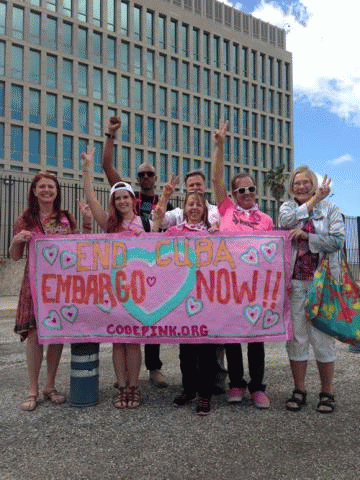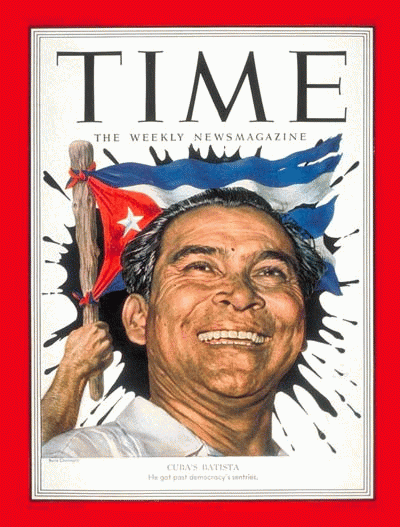
End Cuba embargo! Code Pink delegation in Cuba, Feb, 2015 Swanson
(Image by David Swanson) Details DMCA
Cuba Si, Yankee Imperialism No! End the Blockade of Cuba
Cuba has always evoked a lot of emotion in US politics [HERE ]. During the last 56 years it has been especially so.
Since 1959 the American people have been fed anti-Castro propaganda that brings up images of Cuba as a police state, with political oppression, firing squads, dungeons, enslaved people and desperate attempts by Cubans to escape for freedom to the U.S.A. in leaky and deadly rafts. [Human Rights in Cuba, Human Rights Watch, 2014 World Report ]
Of course, there is an element of truth. Yet there is a lot more to the story of Cuba and the Castro Revolution than one finds in the propaganda.
To understand Cuba today, one needs to know what Cuba was like before Fidel Castro and Che Guevara lead the Cuban Revolution of 1959.
The U.S. Backed Batista Dictatorship Era
From 1952 to 1959 the dictator Fulgencio Batista ruled a repressive government in Cuba with U.S. backing and blessing. Under Batista rule, Cuba was the playground for the Mafia, large land owners, US corporations, Cuban elites and tourists. Cuba was rampant with political corruption, gambling, prostitution, drugs, crime, poverty, illiteracy and racism. Cuban vice was run by US gangsters of the likes of Lucky Luciano, Meyer Lansky and the crime family of Santo Trafficante from Tampa, Florida.
For tourists, Cuba was a place to go to gamble, drink rum, listen to Latin music, sun bath and sleep around. One could go to the Hotel Nacional de Cuba or the Tropicana Club and see show girls such as the "Flesh Goddesses" and stars such as Frank Sinatra, Nat King Cole and Liberace perform. Other than tourism, Cuba's main industries were sugar, rum and their famous cigars. [HERE ]
To say that Cuba was all bad under Batista is just as much of an exaggeration as to say that Cuba is a worker's paradise under Castro today. Cuba was a glamorous place that attracted famous people such as Ernest Hemingway.
Cuba had a vibrant and educated upper class that enjoyed a comfortable and even luxurious living standard. This is what many Cuban exiles living in the US remember most and romanticize about today. Many of the exiles are those that lost their country-club lifestyle and fled Cuba. [HERE ]
Still with all the glamour of old Cuba, it was not a good place to be poor. And most of the people lived in extreme poverty, especially blacks and those living in the countryside.
Illiteracy was high, healthcare was often not available, and employment was at the mercy of the large land owners. Racism was rampant. Political dissent was harshly dealt with by Batista's torturers and death squads.
Fidel Castro and Revolution
Next Page 1 | 2 | 3 | 4 | 5 | 6
(Note: You can view every article as one long page if you sign up as an Advocate Member, or higher).







